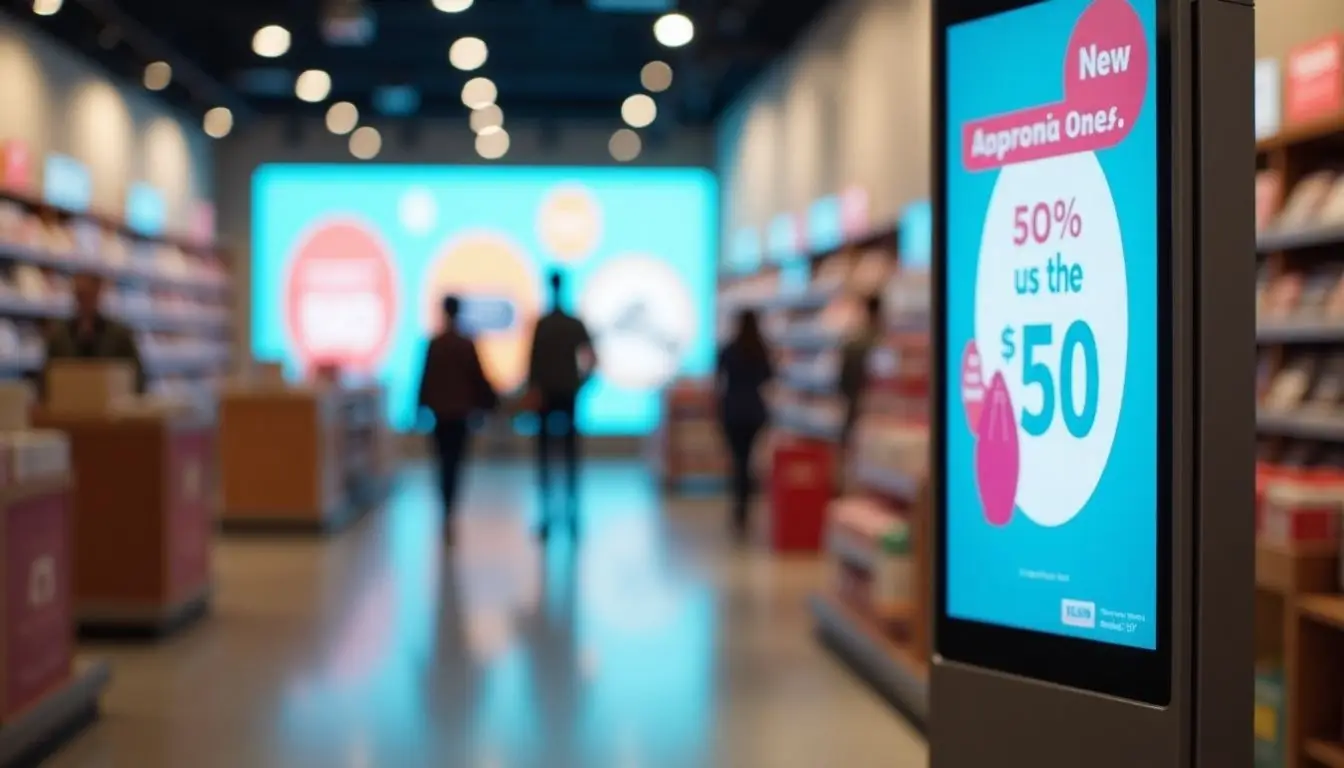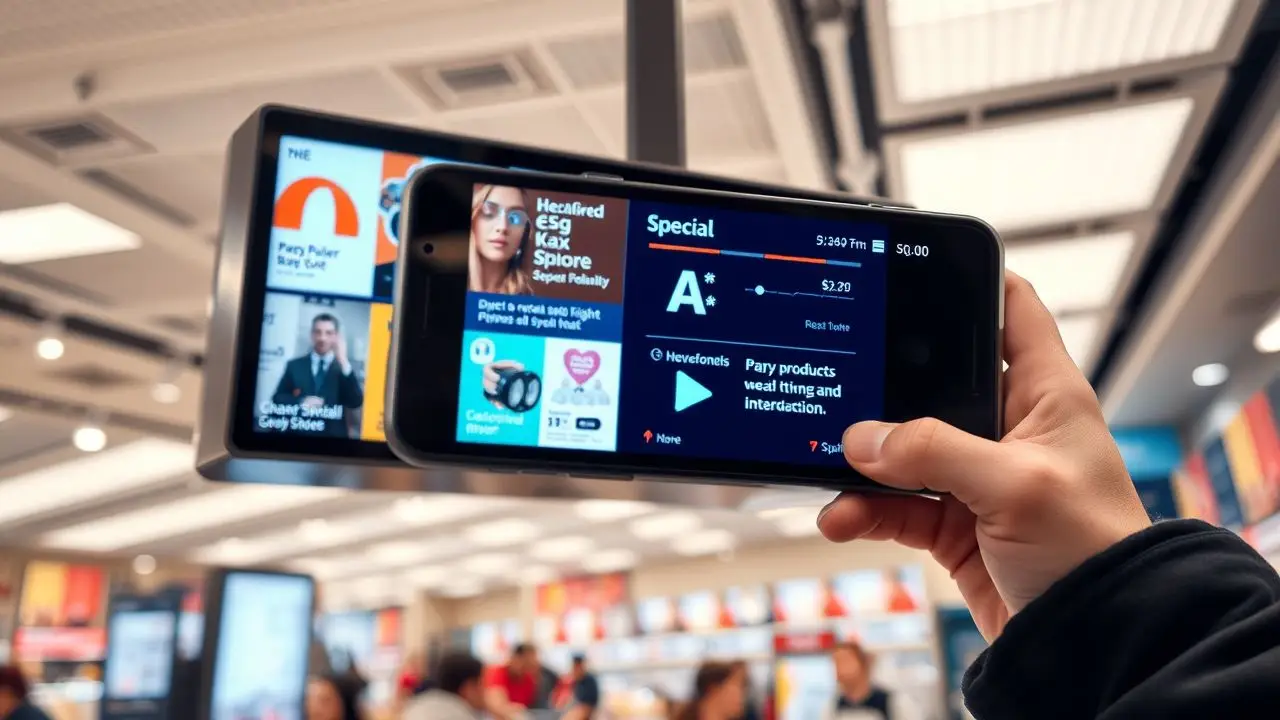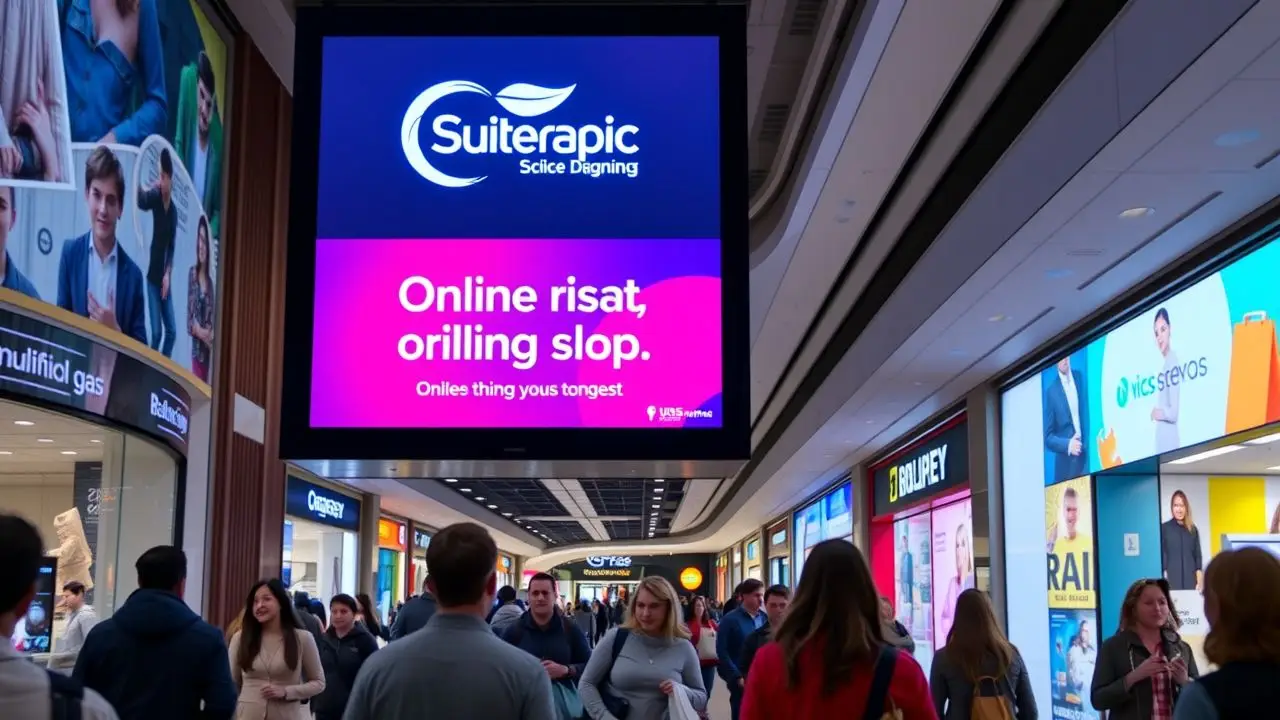Many stores face a big challenge competing with online shops. One fact is clear: digital signage helps in this fight. This blog will show how it can boost customer interest and sales for retailers.
Keep reading to learn more!
Key Takeaways
- Digital signage makes shopping fun and helps shops sell more. It shows moving ads and information that catch people’s eyes.
- Signs can change quickly to show new deals or products, saving money on printing costs and helping the earth by using less paper.
- Using digital signs with online sales details makes buying things in stores better. It connects online and offline shopping for customers.
Table of Contents
ToggleBenefits of Digital Signage in Modern Retail

Digital signage offers many benefits for modern retail. It helps keep customers engaged and makes brands more visible in a crowded market.
Enhanced customer engagement

Digital signage boosts customer engagement in retail stores. It grabs attention and makes shopping fun. Bright screens show promotions, videos, and interactive content. Shoppers can learn about products while they browse.
This technology creates a lively atmosphere. Customers enjoy watching digital displays as they shop. Engaging content keeps them interested longer. Increased engagement leads to better sales growth and positive customer reactions.
Retailers gain an advantage by using smart marketing strategies through digital signs.
Increased brand visibility
 Increased brand visibility is key for retailers. Digital signage catches the eye of shoppers. Bright displays attract attention and draw customers in. A well-placed screen can highlight sales and new products.
Increased brand visibility is key for retailers. Digital signage catches the eye of shoppers. Bright displays attract attention and draw customers in. A well-placed screen can highlight sales and new products.
This grabs interest better than static signs.
Stores use digital displays to change content quickly. For example, a clothing store can showcase different outfits throughout the day. Visitors see fresh ads that keep them engaged.
Studies show that stores with digital signage see more foot traffic and higher sales numbers. Retailers gain an edge over e-commerce by creating engaging instore experiences through eye-catching visuals and value-added content.
Cost-effective advertising

Digital signage offers cost-effective advertising for retailers. It allows stores to display promotions and products without high printing costs. Instead of printing new posters, stores can easily change digital content.
This helps save money and time.
Retailers can run targeted ads to reach specific customers. For example, a store might show discounts on summer clothes when the weather gets warm. Using appealing visuals enhances customer interaction and draws attention to sales.
Digital signs make it easy to share value-added content that keeps shoppers engaged while they browse in-store or shop online.
Flexibility and versatility
 Flexibility and versatility are key features of digital signage. Retailers can change content quickly. They can show special offers, new products, or events in real time. This ability helps brands stay fresh and relevant in an active market.
Flexibility and versatility are key features of digital signage. Retailers can change content quickly. They can show special offers, new products, or events in real time. This ability helps brands stay fresh and relevant in an active market.
Digital signs allow for different types of displays too. They can feature eye-catching visuals or interactive elements. This draws customers in and enhances their shopping experience.
Retail technology is always shifting, so businesses must adapt fast to keep up with trends. Digital signage makes that easier by providing retail innovation at their fingertips.
Eco-friendly practices
Digital signage promotes eco-friendly practices in retail. It reduces paper waste by replacing traditional signs. Stores do not need to print flyers or posters for every sale. Instead, they can update digital displays instantly.
This simple change helps cut down on materials used and thrown away.
Using energy-efficient screens also supports the environment. Many digital signs now use LED technology. These lights consume less power than older models. Retailers see lower energy bills while being kind to nature at the same time.
By choosing green options, stores show customers they care about the planet and their shopping experience improves too.
Competitive advantage
Retailers gain a competitive advantage with digital signage. Customers see bright, engaging displays that showcase promotions and new products. This helps stores stand out in the busy market of e-commerce competition.
Digital signs can show personalized experiences based on shopper preferences. They create an inviting atmosphere that makes customers want to stay longer.
Sales increase when stores use smart advertising strategies through digital displays. Retailers can change messages quickly to match trends or events. This flexibility keeps their brand fresh and relevant.
Using interactive displays further enhances the shopping experience. Stores provide information right at the moment shoppers need it, which boosts sales and builds customer loyalty in this omnichannel retail space.
How Digital Signage Can Complement E-Commerce

Digital signage can improve the shopping experience for customers. It showcases online deals in stores, helping brands stand out and drive more sales.
Enhances customer experience
Digital signage improves the customer experience in stores. It grabs attention with bright visuals and animations. Shoppers enjoy engaging displays that show promotions or new products.
This makes finding what they need easier and more exciting.
Creating an ambient shopping environment is key to competing in e-commerce. Digital signs can display personalized advertising based on shoppers’ preferences. This tailored approach makes customers feel valued, which boosts sales.
Retailers using digital signage stand out by blending online competition with real-life interactions, enhancing the overall shopping journey for everyone involved.
Boosts brand image
Strong branding is key for retailers. Digital signage helps create a memorable image. Bright screens display catchy ads and promotions. This attracts customers and keeps their attention.
Clear visuals make products stand out. Stores can showcase new items or deals quickly. This instant update reflects a modern brand that cares about consumer behavior. An appealing presentation builds trust with shoppers.
Happy customers often return, boosting sales in the long run. Retailers compete effectively with e-commerce by enhancing their brand image through engaging displays and digital advertising.
Increases sales
Digital signage boosts sales in retail. It grabs customer attention and promotes offers instantly. Screens display deals, new products, or promotions that catch the eye. This form of in-store marketing can lead to quick purchases.
Retailers also use digital signage for visual merchandising. Colorful and moving images make products more appealing. They highlight what’s popular or on sale, enticing shoppers to buy more items.
By enhancing the shopping experience with value-added content, retailers keep customers engaged longer and increase overall sales revenue as a result of an omnichannel experience.
Facilitates omnichannel strategies
Omnichannel strategies help retailers reach customers in different ways. Digital signage plays a key role in this approach. It makes the shopping experience seamless for consumers.
For example, a shopper can see a product on social media and then find it in-store with clear digital displays.
Retailers use these signs to connect online and offline sales. They show live inventory updates or special discounts that match what shoppers see online. Many businesses have found that this method boosts their brand image and increases sales.
First-hand experience shows that stores with digital signage often attract more foot traffic than those without it.
Streamlines operations
Digital signage streamlines operations for retailers. It allows quick updates to pricing and promotions. This saves time and cuts down on miscommunication. Retailers can change their messages in seconds.
They do not need to print new signs every time.
Using digital displays helps with inventory management too. Shops can show stock levels or highlight sold-out items. This provides a seamless shopping experience for customers. Stores that integrate e-commerce elements will likely see increased sales and improved brand image through clear, engaging content.
Tips for Integrating Digital Signage with E-Commerce

To make digital signage work with e-commerce, keep your branding consistent. Use bright displays to catch shoppers’ eyes and direct them online.
Consistent branding
Consistent branding is key for retailers. It helps customers recognize a brand quickly. Digital signage makes this easier. Stores can show the same logos and colors across all platforms, both online and offline.
This creates a strong image in customers’ minds.
With digital displays, brands share important messages clearly. The visuals can match those found on e-commerce sites. This consistency builds trust with shoppers. Customers feel more comfortable buying when they see familiar designs everywhere, whether in-store or online.
Consistent branding through digital signage supports retail trends and helps businesses stand out against e-commerce competition.
Eye-catching retail displays
Eye-catching retail displays grab customer attention. Bright colors and moving images make products stand out. Digital signage can show promotions or new items quickly. This not only attracts shoppers but keeps them engaged longer.
A well-placed display can boost sales by showcasing value-added content. Retailers that use digital screens see more customers drawn in, even against ecommerce competition. These signs help create a lively shopping experience that online stores can’t match.
Targeted advertising
Targeted advertising helps retailers reach specific customers. Digital signage can show ads based on customer habits and preferences. For example, a clothing store might display ads for jackets when it starts to get cold outside.
This makes the message more relevant and appealing.
Retailers can also use data from e-commerce to guide their advertising in-store. By using this information, they can showcase products that shoppers usually buy online but may want to see up close.
Targeted ads increase sales by drawing attention to items customers really want, making instore marketing much more effective.
Syncing pricing updates
Retailers can easily sync pricing updates using digital signage. This feature allows stores to change prices quickly and efficiently. Instead of printing new labels, signs update automatically on screens.
Customers see the correct price right away.
This keeps the retail experience smooth and simple for shoppers. It helps avoid confusion about costs. Pricing updates align with e-commerce changes too. If a product’s price drops online, it can reflect in-store instantly.
Digital signage connects both worlds seamlessly, giving retailers an edge over competitors in e-commerce integration.
Utilizing retail technology trends
Retail technology trends are changing how stores operate. Digital signage is a big part of this change. Many shops use screens to show deals or new products. This catches the eye of customers and keeps them interested.
Using digital signage can help retailers compete with e-commerce. It makes shopping more fun and interactive. For example, touch screens can let customers learn about products right away.
These tools can also enhance customer experience by providing value-added content like reviews and recommendations. First-hand experience shows that shoppers who see engaging displays often buy more items than those who do not.
Retailers can also update information quickly, keeping everything current and relevant based on online sales trends.
Conclusion

Digital signage is a powerful tool for retailers. It helps them stand out against online stores. Bright screens attract attention and engage customers. This boosts sales and builds brand loyalty.
Retailers can thrive by using digital signage wisely.
FAQs
1. How does digital signage help retailers compete with e-commerce?
Digital signage gives stores an edge over e-commerce by providing value-added content and integrating aspects of online shopping into the physical retail environment.
2. What is value-added content in terms of digital signage?
Value-added content refers to information that enhances the customer experience, such as product details, reviews or special offers displayed on digital signs.
3. How can retailers integrate ecommerce with their physical stores through digital signage?
Retailers can use digital signs to display online inventory, promote web-exclusive deals or demonstrate how to use their e-commerce platforms for a seamless shopping experience.
4. Can using digital signage really make a significant difference for brick-and-mortar retailers against e-commerce competition?
Yes! By combining the tactile advantages of physical retail with dynamic, engaging displays from the virtual world, shops can offer unique experiences that stand up against pure online sellers.




